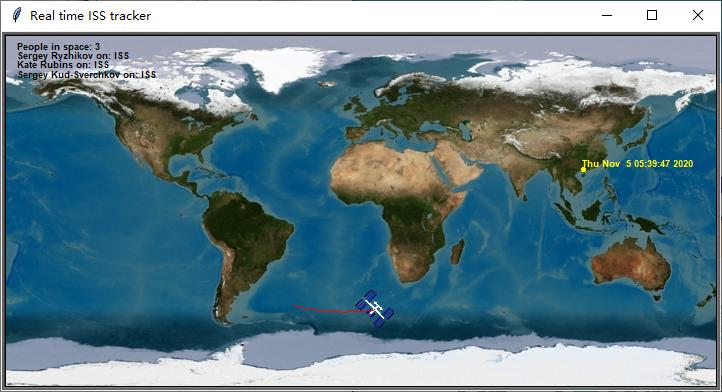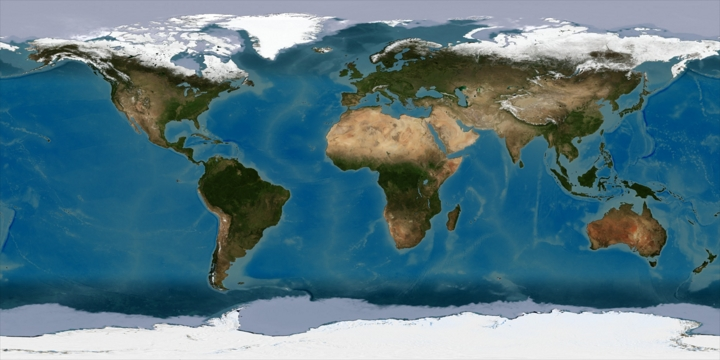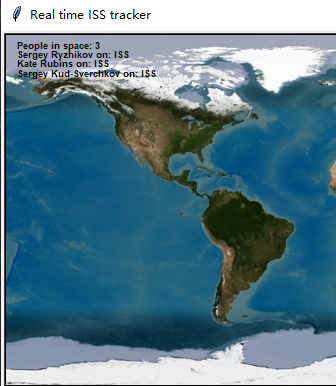利用NASA的数据接口制作国际空间站实时跟踪器

大家好,欢迎来到 Crossin的编程教室 !
今天给大家分享一个开源项目:Open Notify。它的目的是将 NASA(美国国家航空航天局)的一些数据开放为简单的编程接口。
open-notify.org 的作者做了一些工作,以获取原始数据并将其转换为与太空和航天器有关的API。
本文将通过这个接口,获取得到国际空间站的位置,并实时地绘制到地图上:
感谢 cr0sis/Real-time-International-space-station-tracker 的贡献。
为了实现本文的目标,你得先安装 ISS_Info:
pip install ISS-Info
下面分步骤讲解整套绘制流程
1.地图初始化
为了实时展示国际空间站的路径,需要使用turtle绘制曲线,因此可以创建一个turtle画布,将背景设为地球:
import ISS_Infoimport turtleimport timeimport jsonimport urllib.requestscreen = turtle.Screen()screen.setup(720,360)screen.setworldcoordinates(-180,-90,180,90)screen.bgpic("map.png")screen.bgcolor("black")screen.register_shape("isss.gif")screen.title("Real time ISS tracker")iss = turtle.Turtle()iss.shape("isss.gif")

2.获取空间站的人数
如果能知道空间站上的宇航员人数,我们就能更加准确的跟踪国际空间站。幸运的是open-notify确实提供了这样的接口。
为了获取人数信息,我们必须向下列接口请求拿到数据,并将相应的宇航员名字写在左上角:
http://api.open-notify.org/astros.json
astronauts = turtle.Turtle()astronauts.penup()astronauts.color('black')astronauts.goto(-178,86)astronauts.hideturtle()url = "http://api.open-notify.org/astros.json"response = urllib.request.urlopen(url)result = json.loads(response.read())print("There are currently " + str(result["number"]) + " astronauts in space:")print("")astronauts.write("People in space: " + str(result["number"]), font=style)astronauts.sety(astronauts.ycor() - 5)people = result["people"]for p in people:print(p["name"] + " on: " + p["craft"])astronauts.write(p["name"] + " on: " + p["craft"], font=style)astronauts.sety(astronauts.ycor() - 5)

3.绘制空间站位置
为了能够绘制空间站的实时位置,我们需要请求拿到空间站的位置信息。请求的接口是:
http://api.open-notify.org/iss-now.json
不过作者将其封装成了一个函数,我们直接调用 iss_current_loc 即可,循环获取国际空间站位置:
while True:location = ISS_Info.iss_current_loc()lat = location['iss_position']['latitude']lon = location['iss_position']['longitude']print("Position: \n latitude: {}, longitude: {}".format(lat,lon))pos = iss.pos()posx = iss.xcor()if iss.xcor() >= (179.1): ### Stop drawing at the right edge ofiss.penup() ### the screen to avoid aiss.goto(float(lon),float(lat)) ### horizontal wrap round linetime.sleep(5)else:iss.goto(float(lon),float(lat))iss.pendown()time.sleep(5)
我们还可以标出自己目前所处的位置,以查看和国际空间站的距离及空间站经过你上空的时间点(UTC)。
while True:location = ISS_Info.iss_current_loc()lat = location['iss_position']['latitude']lon = location['iss_position']['longitude']print("Position: \n latitude: {}, longitude: {}".format(lat,lon))pos = iss.pos()posx = iss.xcor()if iss.xcor() >= (179.1): ### Stop drawing at the right edge ofiss.penup() ### the screen to avoid aiss.goto(float(lon),float(lat)) ### horizontal wrap round linetime.sleep(5)else:iss.goto(float(lon),float(lat))iss.pendown()time.sleep(5)
不过这里值得注意的是,iss-pass.json这个接口的纬度计算必须在-90到90之内,因此深圳的纬度需要减去90.
最终效果如下:

在公众号Crossin的编程教室回复关键字“国际空间站”可获取本文完整源码
_往期文章推荐_
